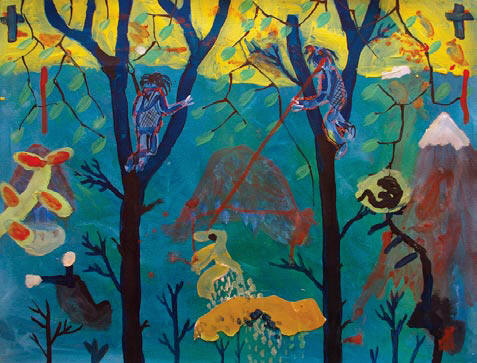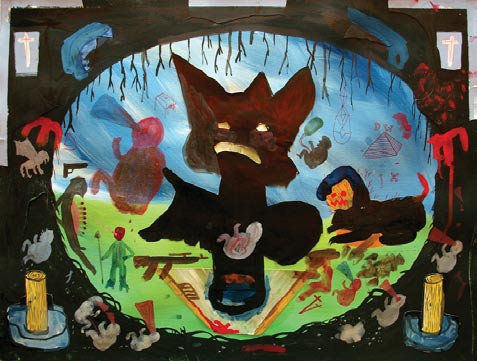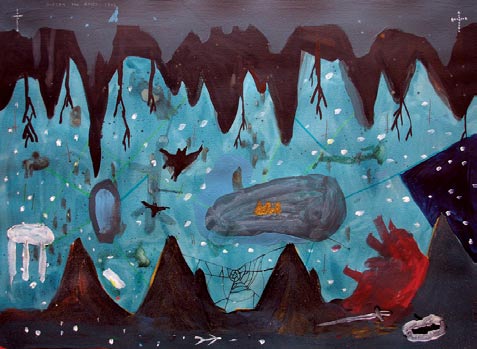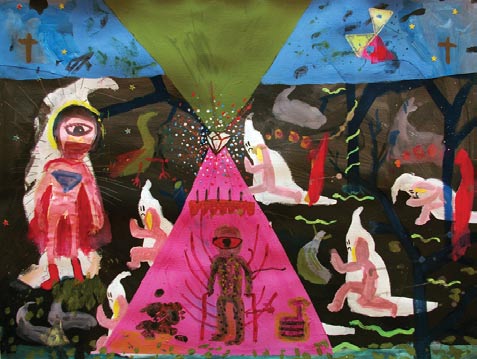|
Daryl Waller: Two Crosses
Goldfish, Penzance
 'Two
hunters' (picture right) is the first painting in this, Daryl Waller's
first solo show at Goldfish. It shows blue trees in a blue forest. In
the branches sit two roughly painted alien figures, one of them with red
rays emerging from its eyes. Executed with child-like simplicity in
brightly coloured gouache, the work in its form at least, is strongly
reminiscent of Roger Hilton's late paintings. It contains the first of
several film references in the exhibition: this time to 'Predator'
starring Arnold Schwarznegger. 'Two
hunters' (picture right) is the first painting in this, Daryl Waller's
first solo show at Goldfish. It shows blue trees in a blue forest. In
the branches sit two roughly painted alien figures, one of them with red
rays emerging from its eyes. Executed with child-like simplicity in
brightly coloured gouache, the work in its form at least, is strongly
reminiscent of Roger Hilton's late paintings. It contains the first of
several film references in the exhibition: this time to 'Predator'
starring Arnold Schwarznegger.
Five works are placed on
the opposite wall in the shape of a cross. Though the links between them
are not clear, they are predominantly yellow and depict pyramids, so
suggesting Egypt and the Middle East. The top painting contains a
version of the Eye of Providence: an icon that features on the American
dollar bill, and thought to be a masonic symbol of the all-seeing eye of
God. The theme of the all-seeing eye, relating as it does eg to the eye
of Horus, appears and reappears in these works, and is particularly
affecting in the small and abject painting: 'Coughing Blood'.
 Religious
themes, and images of crosses also recur. In 'Nature, Red in Tooth and
Claw', a work in black ink on paper, a cloaked Jacobean figure reads a
bible with not one but two crosses on it. The significance of the two
crosses is not clear, but many of the other paintings contain crosses in
the two upper corners, and in some works eg 'Burning Tree' they are very
prominent. The pairing seems to refer to a duality, perhaps to male and
female principles, perhaps to a marital or sexual couple. Religious
themes, and images of crosses also recur. In 'Nature, Red in Tooth and
Claw', a work in black ink on paper, a cloaked Jacobean figure reads a
bible with not one but two crosses on it. The significance of the two
crosses is not clear, but many of the other paintings contain crosses in
the two upper corners, and in some works eg 'Burning Tree' they are very
prominent. The pairing seems to refer to a duality, perhaps to male and
female principles, perhaps to a marital or sexual couple.
Two of the strongest paintings are in the stairs. Both 'Robert the
Bruce' and 'Vision' are very beautiful. The latter (picture above left)
comprises a looming black spectre rising up in the middle of the scene,
surrounded by barely formed foetus-like figures, guns and blobs of
paint. 'Robert the Bruce' (below right) looks like an underwater cave,
its blue background like the sea or a night sky, glinting with glitter.
'Uberman with a Jesus Mask' (below left) - the title probably referring
to Neitzche's Ubermench - in the first floor gallery is an image of a
superman-like figure complete with red cloak and red pants, and a single
large cyclops eye. Several acolytes in the form of little white ghosts
appear to bow down before him, though each of these ghosts also has a
fleshy pink figure inside it. As an image of body and soul combined,
they are both literal and direct. On the floor beneath them is a
sculpture of a pile of bones made simply in clay.
 Five
paintings clustered in another cross, include one with another image of
Superman, this time with lasers emitting from his eyes, standing in a
kind of cemetery. Both works suggest a Hollywood (or Marvel-comic)
god-like figure ruling over the spirits of the afterlife. Five
paintings clustered in another cross, include one with another image of
Superman, this time with lasers emitting from his eyes, standing in a
kind of cemetery. Both works suggest a Hollywood (or Marvel-comic)
god-like figure ruling over the spirits of the afterlife.
Waller likes to keep testing himself and his audience. Whilst the
paintings have a clear, if complex, set of interrelated themes,
'Portrait of the Artist as a Young Man' goes off in another direction
altogether. For the first two weeks of the show Waller was dressed in a
monkey suit and fenced into the smaller of the two galleries on the
first floor. There he could be watched both in the gallery and via a
webcam sitting, reading, drawing and staring into space, whilst behind
his chair a dry-ice machine wafts smoke over and around him (see 'webprojects').
One element that links the performance to the paintings is the
references to film culture. The costume, which is very realistic, had
been bought from e-bay and had been used in a film previously. Another
link is the celebration of naivete or the primitive, and another is the
apparent erasure of Waller's personal biography, which up until now had
been an important feature of his work, but was largely absent from this
collection of paintings. Thus on the night of the private view, he was
there in person, but he was inaccessible, incommunicado and eerily
hidden behind the costume.
 The
catalogue for the show was designed by Waller, and was, in this sense, a
work in its own right. Nihilism and Neitzsche was mentioned more than
once, and both appear to have been an important influence on the artist
in the period leading up to the exhibition. Nietzsche was not himself a
nihilist, but described nihilism as a condition of modern man, who no
longer has faith or a set of absolute ideals and morals to believe in. A
number of commentators, such as Baudrillard, have linked this to
cultural and moral relativism: one of the core features of
post-modernism. The
catalogue for the show was designed by Waller, and was, in this sense, a
work in its own right. Nihilism and Neitzsche was mentioned more than
once, and both appear to have been an important influence on the artist
in the period leading up to the exhibition. Nietzsche was not himself a
nihilist, but described nihilism as a condition of modern man, who no
longer has faith or a set of absolute ideals and morals to believe in. A
number of commentators, such as Baudrillard, have linked this to
cultural and moral relativism: one of the core features of
post-modernism.
Whether it is useful for
artists to invoke such intellectual heavy-weights is debatable, however
the 'relativism' of 'Two Crosses' results in a powerful collection of
dense and complex works in which timeless religious iconography rubs up
against contemporary archetypes, to create a fascinating - and
liberating - total world view. This view is one that is able to connect
in a multitude of ways with important themes, using a completely
contemporary language.
Perhaps because of its
affiliation with abstract art, and with 'beaux pienture', too much art
from Cornwall is simply decorative and lacks genuine meaning or content.
Waller is one of only a handful of artists working or showing here
seemingly willing, or able, to change this.
Portrait of the artist as a Young Man can be viewed on the webproject
page or on the Goldfish website
RW 19/5/08
|

 'Two
hunters' (picture right) is the first painting in this, Daryl Waller's
first solo show at Goldfish. It shows blue trees in a blue forest. In
the branches sit two roughly painted alien figures, one of them with red
rays emerging from its eyes. Executed with child-like simplicity in
brightly coloured gouache, the work in its form at least, is strongly
reminiscent of Roger Hilton's late paintings. It contains the first of
several film references in the exhibition: this time to 'Predator'
starring Arnold Schwarznegger.
'Two
hunters' (picture right) is the first painting in this, Daryl Waller's
first solo show at Goldfish. It shows blue trees in a blue forest. In
the branches sit two roughly painted alien figures, one of them with red
rays emerging from its eyes. Executed with child-like simplicity in
brightly coloured gouache, the work in its form at least, is strongly
reminiscent of Roger Hilton's late paintings. It contains the first of
several film references in the exhibition: this time to 'Predator'
starring Arnold Schwarznegger.  Religious
themes, and images of crosses also recur. In 'Nature, Red in Tooth and
Claw', a work in black ink on paper, a cloaked Jacobean figure reads a
bible with not one but two crosses on it. The significance of the two
crosses is not clear, but many of the other paintings contain crosses in
the two upper corners, and in some works eg 'Burning Tree' they are very
prominent. The pairing seems to refer to a duality, perhaps to male and
female principles, perhaps to a marital or sexual couple.
Religious
themes, and images of crosses also recur. In 'Nature, Red in Tooth and
Claw', a work in black ink on paper, a cloaked Jacobean figure reads a
bible with not one but two crosses on it. The significance of the two
crosses is not clear, but many of the other paintings contain crosses in
the two upper corners, and in some works eg 'Burning Tree' they are very
prominent. The pairing seems to refer to a duality, perhaps to male and
female principles, perhaps to a marital or sexual couple. Five
paintings clustered in another cross, include one with another image of
Superman, this time with lasers emitting from his eyes, standing in a
kind of cemetery. Both works suggest a Hollywood (or Marvel-comic)
god-like figure ruling over the spirits of the afterlife.
Five
paintings clustered in another cross, include one with another image of
Superman, this time with lasers emitting from his eyes, standing in a
kind of cemetery. Both works suggest a Hollywood (or Marvel-comic)
god-like figure ruling over the spirits of the afterlife.  The
catalogue for the show was designed by Waller, and was, in this sense, a
work in its own right. Nihilism and Neitzsche was mentioned more than
once, and both appear to have been an important influence on the artist
in the period leading up to the exhibition. Nietzsche was not himself a
nihilist, but described nihilism as a condition of modern man, who no
longer has faith or a set of absolute ideals and morals to believe in. A
number of commentators, such as Baudrillard, have linked this to
cultural and moral relativism: one of the core features of
post-modernism.
The
catalogue for the show was designed by Waller, and was, in this sense, a
work in its own right. Nihilism and Neitzsche was mentioned more than
once, and both appear to have been an important influence on the artist
in the period leading up to the exhibition. Nietzsche was not himself a
nihilist, but described nihilism as a condition of modern man, who no
longer has faith or a set of absolute ideals and morals to believe in. A
number of commentators, such as Baudrillard, have linked this to
cultural and moral relativism: one of the core features of
post-modernism.